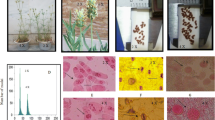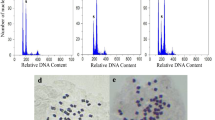Abstract
Ispaghul (Plantago ovata Forsk.) as an important medicinal plant has obtained a remarkable reputation due to therapeutic applications of seed mucilage. To determine the effect of in vitro-induced polyploidy on various characteristics of P. ovata, the terminal bud of two true leaves seedlings were separately treated with colchicine [0.1, 0.3 and 0.5% (w/v) for 6, 12 and 24 h] and trifluralin [7.5, 15 and 22.5% (w/v) for 24, 48 and 72 h] solutions. The ploidy level of induced tetraploids was determined via chromosome counting of root tip cells, and then confirmed through flow-cytometric analysis. Comparison the morphological, physiological, anatomical features of intact diploids and induced tetraploids revealed that tetraploids had considerable more height, thicker leaf, larger spike and seed, larger pollen grain and more seeds per spike. Moreover, the amount of chlorophyll (a, b, and total) and carotenoids, as well as chloroplast number in guard cells was further in tetraploids than diploids. Unlike density, stomata size in tetraploids was bigger than that one in diploids. It was also observed that seeds of tetraploids had more mucilage than diploids. In summary, we firstly developed the P. ovata tetraploids and suggested 0.3% colchicine for 24 h and 22.5% trifluralin for 72 h as the optimum treatments for inducing tetraploidy in P. ovata.

Similar content being viewed by others
References
Abdoli M, Moieni A, Badi HN (2013) Morphological, physiological, cytological and phytochemical studies in diploid and colchicine-induced tetraploid plants of Echinacea purpurea (L.). Acta Physiol Plant 35:2075–2083
Acanda Y, Martinez O, Gonzalez MV, Prado MJ, Rey M (2015) Highly efficient in vitro tetraploid plant production via colchicine treatment using embryogenic suspension cultures in grapevine (Vitis vinifera cv. Menca). Plant Cell Tissue Organ Cult 123:547–555
Adaniya S, Shirai D (2001) In vitro induction of tetraploid ginger (Zingiber officinale Roscoe) and its pollen fertility and germinability. Sci Hortic 88:277–287
Amiri S, Kazemitabaar S, Ranjbar G, Azadbakht M (2010) The effect of trifluralin and colchicine treatments on morphological characteristics of jimsonweed (Datura Stramonium L.). Trakia J Sci 8:47–61
Bagheri M, Mansouri H (2015) Effect of induced polyploidy on some biochemical parameters in Cannabis sativa L. Appl Biochem Biotechnol 175:2366–2375
Bahmani M, Mirhosseini M, Fasihzadeh S, Karimian P, Rafieian-kopaei M (2016) Plantago: a plant for internists. Der Pharm Chem 8:84–91
Bannayan M, Nadjafi F, Azizi M, Tabrizi L, Rastgo M (2008) Yield and seed quality of Plantago ovata and Nigella sativa under different irrigation treatments. Ind Crops Prod 27:11–16
Berkov S, Philipov S (2002) Alkaloid production in diploid and autotetraploid plants of Datura stramonium. Pharma Biol. 40:617–621
Bouvier L, Fillon FR, Lespinasse Y (1994) Oryzalin as an efficient agent for chromosome doubling of haploid apple shoots in vitro. Plant Breed 113:343–346
Chen LL, Gao SL (2007) In vitro tetraploid induction and generation of tetraploids from mixoploids in Astragalus membranaceus. Sci Hortic 112:339–344
Denham TP, Iriarte J, Vrydaghs L (2016) Rethinking agriculture archaeological and ethnoarchaeological perspectives, 1st edn. Routledge, London, pp 44–57
Dhar MK, Kaul S, Friebe B, Gill BS (2002) Chromosome identification in Plantago ovata Forsk. through C-banding and FISH. Curr Sci 83(2):150–152
Dhar MK, Kaul S, Sareen S, Koul AK (2005) Plantago ovata: cultivation, genetic diversity, chemistry and utilization. Plant Genet Resour 3:252–263
Dhooghe E, Van-Laere K, Eeckhaut T, Leus L, Van-Huylenbroeck J (2011) Mitotic chromosome doubling of plant tissues in vitro. Plant Cell Tissue Organ Cult 104:359–373
Doležel J, Bartoš J (2005) Plant DNA flow cytometry and estimation of nuclear genome size. Ann Bot 95:99–110
Ebadi-Almas D, Karimzadeh G, Mirzaghaderi G (2012) Karyotypic variation and karyomorphology in Iranian endemic ecotypes of Plantago ovata Forsk. Cytologia 77(2):215–223
Gantait S, Mandal N, Bhattacharyya S, Das PK (2011) Induction and identification of tetraploids using in vitro colchicine treatment of Gerbera jamesonii Bolus cv. Sciella. Plant Cell Tissue Organ Cult 106:485–493
Gao SL, Chen BJ, Zhu DN (2002) In vitro production and identification of autotetraploids of Scutellaria baicalensis. Plant Cell Tissue Organ Cult 70:289–293
Głowacka K, Jezowski S, Kaczmarek Z (2010) In vitro induction of polyploidy by colchicine treatment of shoots and preliminary characterization of induced polyploids in two Miscanthus species. Ind Crops Prod 32:88–96
Gu XF, Yang AF, Meng H, Zhang JR (2005) In vitro induction of tetraploid plants from diploid Zizyphus jujyba Mill. cv Zhanhua. Plant Cell Rep 24:671–676
Gupta M, Kaul S, Dhar MK (2018) Identification and characterization of some putative genes involved in arabinoxylan biosynthesis in Plantago ovate. 3 Biotech. https://doi.org/10.1007/s13205-018-1289-9
Hannweg K, Sippel A, Bertling I (2013) A simple and effective method for the micro-propagation and in vitro induction of polyploidy and the effect on floral characteristics of the South African iris, Crocosmia aurea. S Afr J Bot 88:367–372
Javadian N, Karimzadeh G, Sharifi M, Moieni A, Behmanesh M (2017) In vitro polyploidy induction: changes in morphology, podophyllotoxin biosynthesis, and expression of the related genes in Linum album (Linaceae). Planta 245:1165–1178
Jesus-Gonzalez L, Weathers PJ (2003) Tetraploid Artemisia annua hairy roots produce more artemisinin than diploids. Plant Cell Rep 21:809–813
Kaensaksiri T, Soontornchainaksaeng P, Soonthornchareonnon N, Prathanturarug S (2011) In vitro induction of polyploidy in Centella asiatica (L.) urban. Plant Cell Tissue Organ Cult 107:187–194
Karimi D, Heidari B, Daneshnia SN, Dadkhodaie A (2013) Genetic variation and interrelationship of seed mucilage, swelling factor and agronomic traits in Plantago ovata wild accessions. Ann Biol Res 4:175–182
Khosravi P, Kermani MJ, Nematzadeh GA et al (2008) Role of mitotic inhibitors and genotype on chromosome doubling of Rosa. Euphytica 160:267–275
Koocheki A, Tabrizi L, NassiriMahallati M (2007) The effect of irrigation intervals and manure on quantitative and qualitative characteristics of Plantago ovata and Plantago psyllium. Asian J Plant Sci 6(8):1229–1234
Kumar A, Bharti B, Dubey RB (2018) Principles of crop improvement. Lap Lambert Academic Publishing, p 240
Lavania UC (2005) Genomic and ploidy manipulation for enhanced production of phyto-pharmaceuticals. Plant Genet Resour 3:170–177
Lichtenthaler HK, Wellburn AR (1983) Determinations of total carotenoids and chlorophylls a and b of leaf extracts in different solvents. Biochem Soc Trans 11:591–592
Luo Z, Iaffaldano BJ, Cornish K (2018) Colchicine-induced polyploidy has the potential to improve rubber yield in Taraxacum kok-saghyz. Ind Crops Prod 112:75–81
Madani H, Hosseini B, Dehghan E, Rezaei-chiyaneh E (2015) Enhanced production of scopolamine in induced autotetraploid plants of Hyoscyamus reticulatus L. Acta Physiol Plant 37:55–60
Majdi M, Karimzadeh G, Malboobi MA, Omidbaigi R, Mirzaghaderi G (2010) Induction of tetraploidy to feverfew (Tanacetum parthenium Schulz-Bip.): morphological, physiological, cytological, and phytochemical changes. HortScience 45:16–21
Pan-pan H, Wei-Xu L, Hui-Hui L, Zeng-Xu X (2018) In vitro induction and identification of autotetraploid of Bletilla striata (Thunb.) Reichb.f. by colchicine treatment. Plant Cell Tissue Organ Cult 132:425–432
Pansuksan K, Sangthong R, Nakamura I, Mii M, Supaibulwatana K (2014) Tetraploid induction of Mitracarpus hirtus L. by colchicine and its characterization including antibacterial activity. Plant Cell Tissue Organ Cult 117:381–391
Predieri S (2001) Mutation induced and tissue culture in improving fruits. Plant Cell Tissue Organ Cult 64:185–210
Rehana K, Ovidiu T, Mihaela AM, Cameli S (2015) Industrial application of psyllium: an overview. Acta Univ Cibin Technol Ser 67:210–214
Roy AT, Leggett G, Koutoulis A (2001) In vitro tetraploid induction and generation of tetraploids from mixoploids in hop (Humulus lupulus L.). Plant Cell Rep 20:489–495
Sabzehzari M, Naghavi MR (2018) Phyto-miRNA: a molecule with beneficial abilities for plant biotechnology. Gene 683:28–34
Sabzehzari M, Naghavi MR (2019) Phyto-miRNAs-based regulation of metabolites biosynthesis in medicinal plants. Gene 682:13–24
Sabzehzari M, Hoveidamanesh S, Modarresi M, Mohammadi V (2019) Morphological, anatomical, physiological, and cytological studies in diploid and tetraploid plants of Plantago Psyllium. Plant Cell Tissue Organ Cult 139:131–137
Sadat-Noori SA, Norouzi M, Karimzadeh G, Shirkool K, Niazian M (2017) Effect of colchicine induced polyploidy on morphological characteristics and essential oil composition of ajowan (Trachyspermum ammi L.). Plant Cell Tissue Organ Cult 130:543–551
Saeedi M, Morteza-Semnani K, Ansoroudi F, Fallahi S, Amin G (2010) Evaluation of binding properties of Plantago psyllium seed mucilage. Acta Pharm 60:339–348
Salma U, Kundu S, Mandal N (2017) Artificial polyploidy in medicinal plants: advancement in the last two decades and impending prospects. J Crop Sci Biotech 20:9–19
Salma U, Kundu S, Kumar-Hazra A, Ali N, Mandal N (2018) Augmentation of wedelolactone through in vitro tetraploid induction in Eclipta alba (L.) Hassk. Plant Cell Tissue Organ Cult 133:289–298
Shahriari Z, Heidari B, Dadkhodaie A, Richards CM (2018) Analysis of karyotype, chromosome characteristics, variation in mucilage content and grain yield traits in Plantago ovata and P. psyllium species. Ind Crops Prod 123:676–686
Shao J, Chen C, Deng X (2003) In vitro induction of tetraploid in pomegranate (Punica granatum). Plant Cell Tissue Organ Cult 75:241–246
Sharma PK, Koul A (1986) Mucilage in seeds of Plantago ovata and its wild allies. J Ethnopharmacol 17:289–295.
Tang ZQ, Chen DL, Song ZJ, He YC, Cai DT (2010) In vitro induction and identification of tetraploid plants of Paulownia tomentosa. Plant Cell Tissue Organ Cult 102:213–220
Tavan M, Mirjalili MH, Karimzadeh G (2015) In vitro polyploidy induction: changes in morphological, anatomical and phytochemical characteristics of Thymus persicus (Lamiaceae). Plant Cell Tissue Organ Cult 122:573–583
Urwin NA, Horsnell J, Moon T (2007) Generation and characterization of colchicine-induced autotetraploid Lavandula angustifolia. Euphytica 156:257–266
Zeng HZ, Chen CW, Hong L, Liu JH, Deng XX (2006) In vitro induction, regeneration and analysis of autotetraploids derived from protoplasts and callus treated with colchicine in citrus. Plant Cell Tissue Organ Cult 87:85–93
Zhang Z, Dai H, Xiao M, Liu X (2008) In vitro induction of tetraploids in Phlox subulata L. Euphytica 159:59–65
Zhang QY, Luo FX, Liu L, Guo FC (2010) In vitro induction of tetraploids in crape myrtle (Lagerstroemia indica L.). Plant Cell Tissue Organ Cult 101:41–47
Acknowledgements
This study was carried out with the financial assistance of University of Tehran, as well as Persian Gulf University, Iran.
Author information
Authors and Affiliations
Contributions
All authors equally participated into this work.
Corresponding author
Ethics declarations
Conflict of interest
Authors have nothing to disclose with regard to commercial support.
Additional information
Publisher's Note
Springer Nature remains neutral with regard to jurisdictional claims in published maps and institutional affiliations.
Rights and permissions
About this article
Cite this article
Sabzehzari, M., Hoveidamanesh, S., Modarresi, M. et al. Morphological, anatomical, physiological, and cytological studies in diploid and tetraploid plants of Ispaghul (Plantago ovata Forsk.). Genet Resour Crop Evol 67, 129–137 (2020). https://doi.org/10.1007/s10722-019-00846-x
Received:
Accepted:
Published:
Issue Date:
DOI: https://doi.org/10.1007/s10722-019-00846-x




